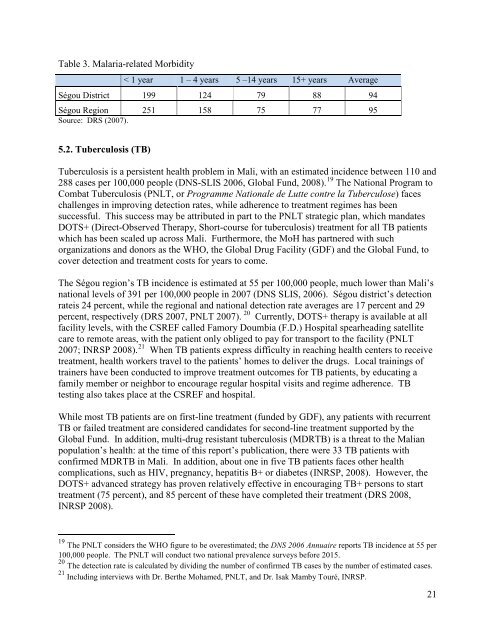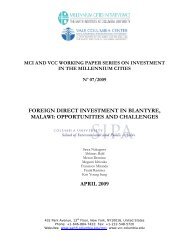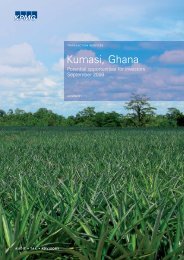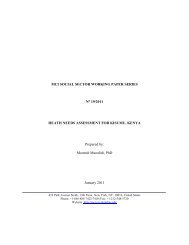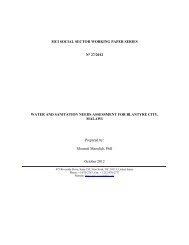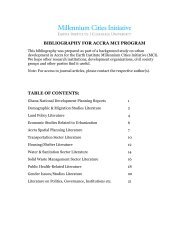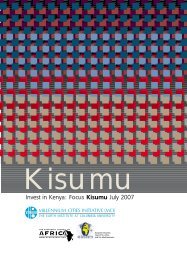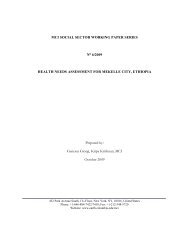Health Needs Assessment for the City of Segou, Mali - Millennium ...
Health Needs Assessment for the City of Segou, Mali - Millennium ...
Health Needs Assessment for the City of Segou, Mali - Millennium ...
You also want an ePaper? Increase the reach of your titles
YUMPU automatically turns print PDFs into web optimized ePapers that Google loves.
Table 3. Malaria-related Morbidity<br />
< 1 year 1 – 4 years 5 –14 years 15+ years Average<br />
Ségou District 199 124 79 88 94<br />
Ségou Region 251 158 75 77 95<br />
Source: DRS (2007).<br />
5.2. Tuberculosis (TB)<br />
Tuberculosis is a persistent health problem in <strong>Mali</strong>, with an estimated incidence between 110 and<br />
288 cases per 100,000 people (DNS-SLIS 2006, Global Fund, 2008). 19<br />
The National Program to<br />
Combat Tuberculosis (PNLT, or Programme Nationale de Lutte contre la Tuberculose) faces<br />
challenges in improving detection rates, while adherence to treatment regimes has been<br />
successful. This success may be attributed in part to <strong>the</strong> PNLT strategic plan, which mandates<br />
DOTS+ (Direct-Observed Therapy, Short-course <strong>for</strong> tuberculosis) treatment <strong>for</strong> all TB patients<br />
which has been scaled up across <strong>Mali</strong>. Fur<strong>the</strong>rmore, <strong>the</strong> MoH has partnered with such<br />
organizations and donors as <strong>the</strong> WHO, <strong>the</strong> Global Drug Facility (GDF) and <strong>the</strong> Global Fund, to<br />
cover detection and treatment costs <strong>for</strong> years to come.<br />
The Ségou region’s TB incidence is estimated at 55 per 100,000 people, much lower than <strong>Mali</strong>’s<br />
national levels <strong>of</strong> 391 per 100,000 people in 2007 (DNS SLIS, 2006). Ségou district’s detection<br />
rateis 24 percent, while <strong>the</strong> regional and national detection rate averages are 17 percent and 29<br />
percent, respectively (DRS 2007, PNLT 2007). 20 Currently, DOTS+ <strong>the</strong>rapy is available at all<br />
facility levels, with <strong>the</strong> CSREF called Famory Doumbia (F.D.) Hospital spearheading satellite<br />
care to remote areas, with <strong>the</strong> patient only obliged to pay <strong>for</strong> transport to <strong>the</strong> facility (PNLT<br />
2007; INRSP 2008). 21<br />
When TB patients express difficulty in reaching health centers to receive<br />
treatment, health workers travel to <strong>the</strong> patients’ homes to deliver <strong>the</strong> drugs. Local trainings <strong>of</strong><br />
trainers have been conducted to improve treatment outcomes <strong>for</strong> TB patients, by educating a<br />
family member or neighbor to encourage regular hospital visits and regime adherence. TB<br />
testing also takes place at <strong>the</strong> CSREF and hospital.<br />
While most TB patients are on first-line treatment (funded by GDF), any patients with recurrent<br />
TB or failed treatment are considered candidates <strong>for</strong> second-line treatment supported by <strong>the</strong><br />
Global Fund. In addition, multi-drug resistant tuberculosis (MDRTB) is a threat to <strong>the</strong> <strong>Mali</strong>an<br />
population’s health: at <strong>the</strong> time <strong>of</strong> this report’s publication, <strong>the</strong>re were 33 TB patients with<br />
confirmed MDRTB in <strong>Mali</strong>. In addition, about one in five TB patients faces o<strong>the</strong>r health<br />
complications, such as HIV, pregnancy, hepatitis B+ or diabetes (INRSP, 2008). However, <strong>the</strong><br />
DOTS+ advanced strategy has proven relatively effective in encouraging TB+ persons to start<br />
treatment (75 percent), and 85 percent <strong>of</strong> <strong>the</strong>se have completed <strong>the</strong>ir treatment (DRS 2008,<br />
INRSP 2008).<br />
19<br />
The PNLT considers <strong>the</strong> WHO figure to be overestimated; <strong>the</strong> DNS 2006 Annuaire reports TB incidence at 55 per<br />
100,000 people. The PNLT will conduct two national prevalence surveys be<strong>for</strong>e 2015.<br />
20<br />
The detection rate is calculated by dividing <strong>the</strong> number <strong>of</strong> confirmed TB cases by <strong>the</strong> number <strong>of</strong> estimated cases.<br />
21<br />
Including interviews with Dr. Ber<strong>the</strong> Mohamed, PNLT, and Dr. Isak Mamby Touré, INRSP.<br />
21


